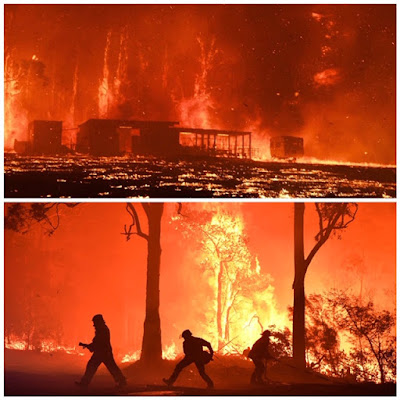This fire which had been burning for a week and was supposedly put out a few days ago, suddenly sprang back to life and headed our way. About 3pm the sky turned dark red and the smoke billowed black and I knew we were in trouble. This was confirmed when kangaroos and wallabies came bounding out of the bush heading east.

So I began to pack up the essentials while the co driver raced home from town.
The fire engines arrived, all 5 of them, and went at first to protect the two houses up the road behind us. The fire roared out of the northwest pushed along by a pretty stiff wind just past our back neighbour's house and headed in our direction. The fire engines and the co driver arrived at our place at the same time so while we were busy throwing stuff in the car, they got to work rolling out hoses etc.

They said it should just miss us and we didn't need to leave but all of a sudden it was in the bush on our western boundary sounding like a jet plane. Luckily it decided to shoot down the creek gully and the firemen got to work keeping it in the bush and away from the house. It burnt across the south west corner of our property and headed for another neighbour. Meanwhile a secondary fire started on our southern boundary and was burning east through some pretty thick undergrowth and trees. Luckily it didn't get to far before it was brought under control.
The main fire just missed our southern neighbour and jumped the highway into the national park and headed for the coast. At 9:45pm, we could see a huge red glow in the sky to the east. We guessed it was time for the people at Bawley Point to be worried.

The firemen (and women) spent a few hours mopping up and putting out the inevitable spot fires and burning logs. All the time you could hear tree crashing down around us in the forest. The firemen call them widow makers.
So they left us breathing a little easier. Well as easy as the copious residual smoke allowed.
After a snack and some wind down time, we went to bed but I was feeling uneasy so got up to check around and found the fire down in the creek had flared up again and was heading up hill against the wind towards the house.
Luckily the firees were still mopping up around the homes behind us and they sent 2 trucks down immediately to deal with my new fire. It is now out but there are so many smouldering logs in the bush and the wind refuses to drop and embers are spraying out everywhere. So I won't be going back to bed tonight. It is now 2am. Added to that there is still a big fire just across the highway in the NP. Luckily the wind is blowing it away from us. It has all been a bit scary. This was my second bad fire here and it's not the best experience!

I will checking for fence damage at sunrise. I managed to get the cattle into the yards early in the piece so they wont be able to wander off if any of the fences are gone....and i think there would have to be some destroyed.
So we are now all hoping for some decent rain to put all the burning logs and stumps out.
To be threatened by fire in winter is something we have never considered a possibility.
The only positive is now we have a huge fire break around us for the summer period.




































